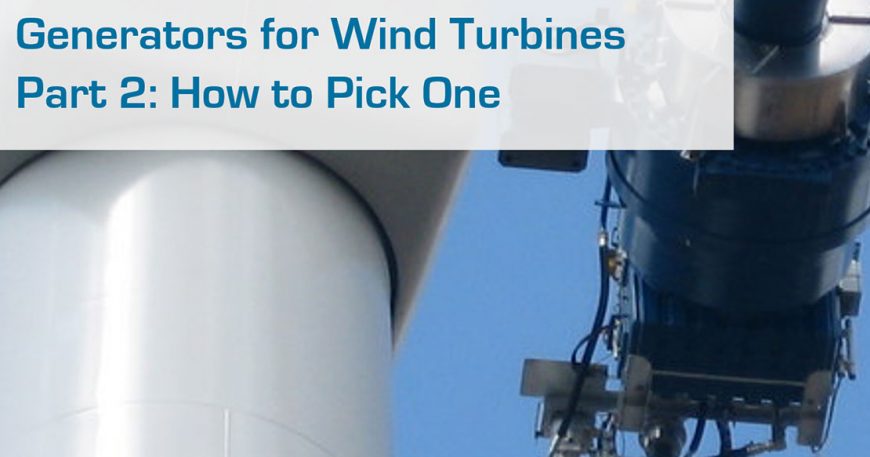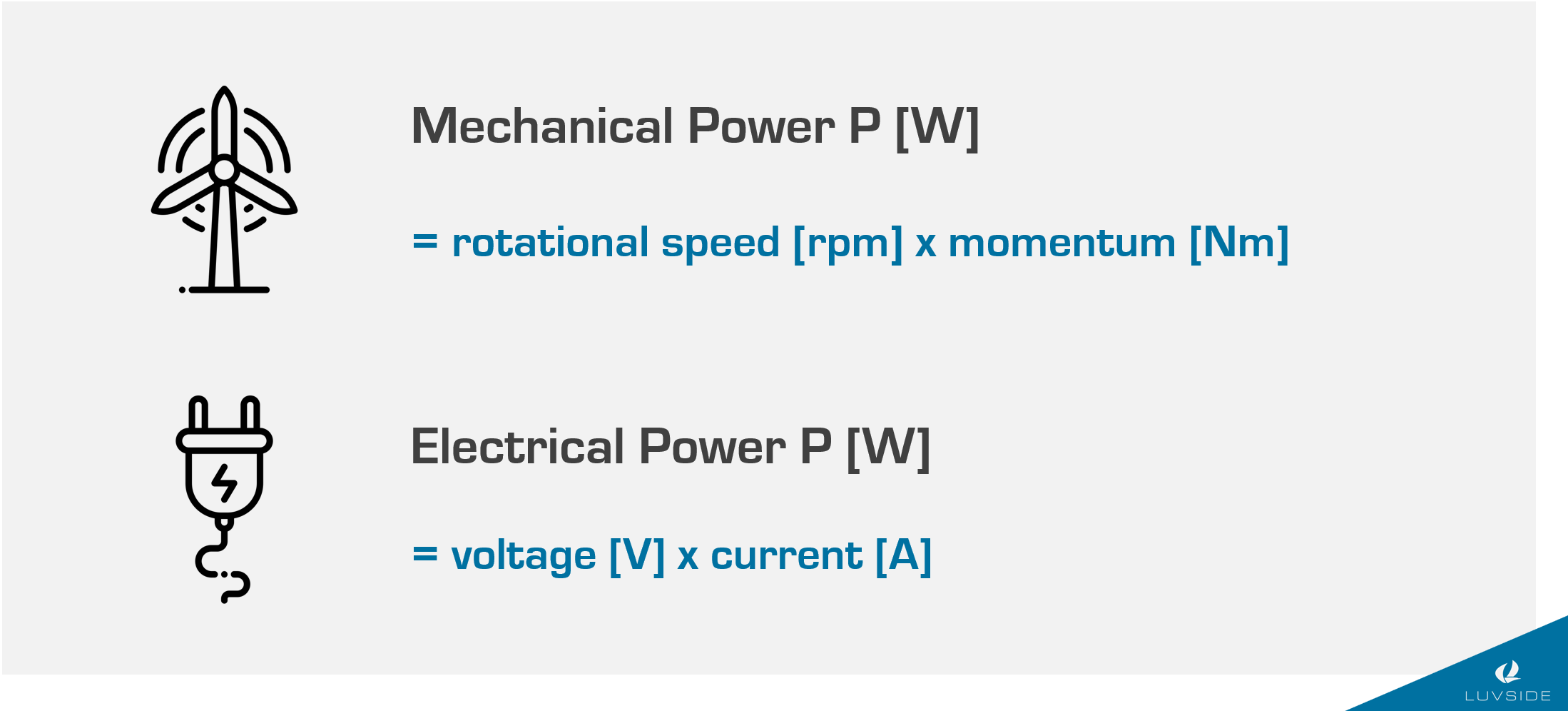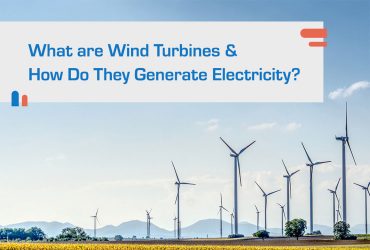
Generator Selection
Different types of generators
There are several types of generators that can be coupled to small wind turbines: most importantly DC or AC types and synchronous or asynchronous that operate with permanent magnets or electrical field excitation respectively. The choice depends on various factors, such as application (stand alone or grid connected), type of load, manufacturability, rated power output, turbine speed and cost. Nevertheless, all these electrical machines are electromechanical devices that work on Faraday’s law of electromagnetic induction.
Synchronous vs. Asynchronous
As explained in the prequel to this article, the rotating part of a generator contains some kind of component that creates a magnetic field. Therefore, it constitutes rotating poles. There are two kinds of components that can fulfil this task.
In so-called synchronous generators, we will find simple permanent magnets. They are similar to horseshoe magnets or to the kind of magnet that you could stick to a fridge. The type of generator that uses permanent magnets is referred to as synchronous because the rotor and the magnetic field rotate with the same speed. Synchronous generators typically have a high power density and low mass, that is why they are increasingly used in wind turbine applications. Challenges imposed by these generators is that under extreme heat development, the permanent magnets can demagnetize, making the generator useless, and that they cannot produce electricity with a fixed frequency. This is because of the variability of the wind speeds and the same-speed rotation. Therefore, these generators require rectifying power converters.
The counterpart to synchronous are asynchronous generators. They create an electric field not using permanent magnets but using extra coils. Faraday’s law suggests that an electric current and a magnetic field always exist together. This allows us to use a magnetic field to induce an electric current in the way that is detailed here, but it also helps us to create a magnetic field by sending a current through a coil. This is exactly what asynchronous generators do. This kind of generator therefore needs a power supply specifically for the magnets, but it is less prone to damage and might be more reliable than its counterpart. Moreover, it has a higher degree of damping so that it can absorb rotor speed fluctuations much more easily.
Dynamos vs. Alternators
The main difference between dynamos and alternators is the type of current they produce: dynamos produce a direct current (DC) while alternators produce an alternating current (AC) that constantly changes flow direction.
For a very basic generator setup, we have learned in the prequel to this article that the produced power output will be AC electricity. The part that allows a dynamo to produce DC power without completely re-designing the concept is called a commutator. At its simplest, it is basically a fixed switch that connects and disconnects to the two different end contacts of the generator’s power circuit as the shaft turns. This allows the commutator to constantly change the polarity of the output current so that in the end, the output is always of the same polarity.
The main advantage of dynamos producing DC current is that most of our electric devices need DC power to function. This means that if you generate AC power, you will always need a power converter to use the electricity in your home.
Nevertheless, alternators producing AC power are far more widespread today. The reason for this is that AC electricity is much simpler and more efficient to transmit via huge power lines. Converting AC power to extremely high voltages for transportation and then reducing it to usable levels again is easy and can be done without significant power losses. The same is very difficult to do with DC currents. Once it has arrived at the desired location for consumption, the AC power can easily be transformed to DC again.
Standard in wind energy: Permanent magnet synchronous generators
The type of generator most used in wind turbines are the permanent magnet synchronous generators. This is because in recent years, they have gained in attractiveness due to improving performance and decreasing cost. Especially for direct-drive turbines, they are competitive because they can have higher pole numbers of 60 or more poles compared to a conventionally would asynchronous generator. This means that despite lower rotational speeds, a reasonable power output frequency can be achieved.
During normal operation, permanent magnet generators are stable and secure and most importantly, they do not need an additional power supply for the excitation circuit to provide a magnetic field. This makes the design and electric connection much simpler and eliminates rotor excitation losses that can make up 20-30 % of the total generator losses. Consequently, power density is high, and the generator remains small and efficient. This is attractive because given that the risk of demagnetization is dealt with properly, it promises low lifetime cost and little problems or maintenance.
The Power Curve
Although it might seem simple, the connection between a wind turbine and a genererator is not just a mechanical one with a shaft and a gearbox. In order to achieve satisfying performance, the wind turbine’s and the generator’s power curves need to be matched.
Generally speaking, there are different types of power, but they have the physical unit watt. There is mechanical power, first contained in wind, then in rotating blades and then, there is electrical power.
On the one hand, the rotational mechanical power contained in a wind turbine’s rotating blades is calculated as the rotor’s rotational speed times its rotational momentum. The speed is essentially how often the shaft turns within a fixed period of time while the momentum corresponds to how much ‘resistance’ or moment of inertia the shaft can turn against. To visualize the momentum, imagine you turn a pencil in your hand. If you hold it loosely, it will be very easy to do so. If you take a tighter grip, you will need to use more effort to keep the pencil turning at the same speed as before. What happens is that you need to apply a higher momentum to it because your tight grip stopping the rotational motion acts similar to a high moment of inertia.
So, the wind turbine rotor’s power output depends on the rotational speed and on the present momentum at any given time. Of course, the power output is not always the exact same, though. It changes significantly as the wind speed increases or decreases. These chances make up a so-called power curve.
On the other hand, electrical power is calculated as a device’s voltage times its current. Simply put, what happens in a generator is that it extracts a portion of the power contained in rotation in order to transform it into electrical power. How much power can be extracted obviously depends on the amount of the power that is present. The problem is that on its own, a generator doesn’t know how much rotational power is there. What it can do, however, is get input from a wind sensor in order to know the present wind speed. Thanks to the turbine’s power curve, its present rotational power can be directly derived from said wind speed. So now, we can decide how much power the generator should extract at any given wind speed and program it to do so. By doing that, we give it its own power curve.

Energy and power output – what’s the difference?
A common misconception when people talk about wind turbines is that they confuse power with energy output. The difference is the following: Power output tells us how much energy is produced compared to a specific time period. Energy output tells us how much energy is actually produced. The unit that is used to indicate energy output is usually kWh – kilo watt hours. An energy production of one kilo watt hour could mean that within one hour, an electric device has procuced exactly one thousand watts of electricity or that within half an our, it has produced two thousand watts of electricity.
So if you want to tell someone how much energy your wind turbine has produced last year, you might say “my turbine has produced 400 kWh – isn’t that cool?”. In this context, talking about power would make little sense. Typically, comparing power output would be useful for example when comparing two different kinds of turbines that operate under the same environmental conditions. Whether it makes sense to talk about power or energy output depends highly on the situation. Nevertheless, know your units – use watts when talking about power and kilo watt hours when talking about energy.
Related Content
The energy transition has already reached urban areas. In addition to solar modules on roofs and green façades, small wind turbines are increasingly being considered...
Since centuries ago, humans have learned to utilize wind power for activities ranging from everyday tasks like grinding grains to long-distance traveling such as sailing....

